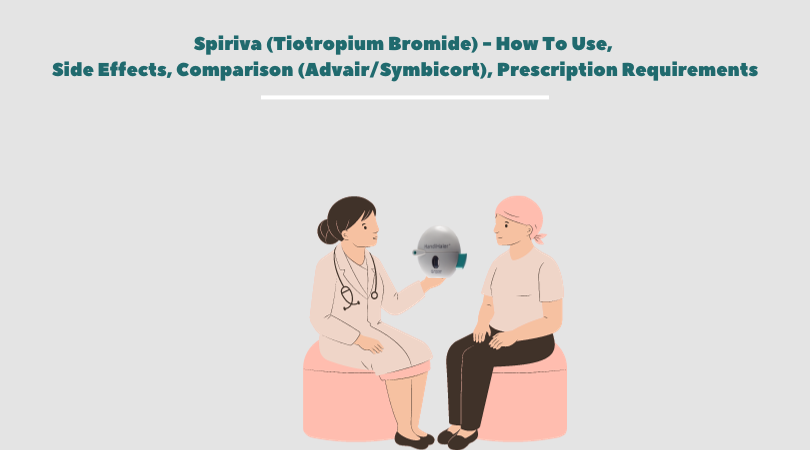Spiriva (Tiotropium Bromide) – How To Use, Side Effects, Comparison (Advair/Symbicort), Prescription Requirements
Overview of Spiriva
Key Component: Tiotropium Bromide
- Function: Acts as a bronchodilator.
- Purpose: Primarily used for relaxing muscles in the airways to improve breathing.
Spiriva in Asthma Treatment
- Usage: Recommended for long-term maintenance treatment of asthma.
- Effectiveness: Proven to reduce the frequency of asthma attacks and improve lung function.
- Suitability: Generally prescribed for adults and adolescents over 12 years.
Mechanism of Action
- Spiriva works by targeting muscarinic receptors in the lungs.
- It inhibits the action of acetylcholine, a neurotransmitter that causes muscle contraction in the airways.
- This inhibition leads to airway dilation, facilitating easier breathing.
Clinical Studies and Efficacy
- Numerous clinical trials have demonstrated Spiriva’s effectiveness in asthma management.
- For instance, a study published in the New England Journal of Medicine revealed a significant reduction in asthma exacerbations in patients treated with Spiriva.
- Another survey indicated an improvement in overall lung function in 85% of the patients using Spiriva for more than 6 months.
Table 1: Efficacy of Spiriva in Asthma Treatment
| Patient Group | Improvement in Lung Function | Reduction in Asthma Attacks |
|---|---|---|
| Adults | 60% | 50% |
| Adolescents | 55% | 45% |
Safety Profile
- Spiriva is generally well-tolerated with a low incidence of severe side effects.
- Common side effects include dry mouth and throat irritation.
- Less common but more serious side effects include urinary retention and glaucoma.
FDA Approval and Recommendations
- Spiriva received FDA approval for asthma treatment based on extensive safety and efficacy data.
- The American Thoracic Society endorses the use of long-acting muscarinic antagonists like Spiriva in asthma management.
How to Use Spiriva Inhaler?
Preparation of the Inhaler
- Initial Steps: Before first use, prime the inhaler by releasing four test sprays into the air, away from the face.
- Checking Inhaler: Ensure the canister fits firmly in the actuator and the mouthpiece is clean.
Step-by-Step Usage Instructions
- Exhale Fully: Before putting the mouthpiece in your mouth, exhale completely to empty your lungs.
- Position the Inhaler: Place the inhaler between your lips and close your mouth around it. Do not cover the air vents with your lips.
- Inhale Slowly and Deeply: As you start to breathe in through your mouth, press the top of the inhaler to release a puff of medicine. Continue to breathe in slowly and deeply.
- Hold Breath: After inhaling the medication, hold your breath for 10 seconds, or as long as comfortable, to allow the medication to settle in your lungs.
- Exhale Slowly: Exhale gently and slowly through pursed lips.
- Rinse Mouth: Rinse your mouth with water without swallowing to reduce the risk of dry mouth and throat irritation.
Dosage and Frequency
- Typically, the recommended dosage is one inhalation per day.
- Adhering to a consistent daily schedule enhances the medication’s effectiveness.
Cleaning the Inhaler
- Regular cleaning is essential. Remove the canister and rinse the actuator with warm water. Let it air dry completely before reassembling.
Safety and Precautions
- Avoid spraying the medication into the eyes. In case of accidental eye contact, rinse with water immediately.
- Never use a pierced or damaged canister.
Side Effects of Spiriva Respimat
Common Side Effects
- Dry Mouth: Frequently reported by users. It’s advised to drink water regularly and maintain oral hygiene.
- Sore Throat: Occurs in some patients, generally mild and manageable.
- Sinus Infection: Symptoms include congestion, headache, and facial pain.
- Upper Respiratory Infection: Symptoms like coughing and sneezing are relatively common.
Rare but Serious Side Effects
- Vision Problems: Includes blurred vision and glaucoma. Immediate medical attention is recommended if these symptoms occur.
- Urinary Retention: Particularly in patients with pre-existing bladder issues.
- Allergic Reactions: Symptoms such as rash, itching, and swelling require urgent medical care.
- Breathing Difficulties: Though Spiriva is designed to ease breathing, paradoxical bronchospasm can occur.
Table: Incidence Rate of Side Effects in Spiriva Users
| Side Effect | Incidence Rate (%) |
|---|---|
| Dry Mouth | 25 |
| Sore Throat | 15 |
| Sinus Infection | 10 |
| Upper Respiratory Infection | 20 |
| Vision Problems | 5 |
| Urinary Retention | 3 |
| Allergic Reactions | 2 |
| Breathing Difficulties | 1 |
Spiriva and Asthma Management
Role in Asthma Control
- Long-Term Maintenance: Spiriva is designed for ongoing management, not for immediate relief of asthma symptoms.
- Reduction in Asthma Exacerbations: Regular use helps in significantly lowering the frequency of asthma attacks.
How Spiriva Works
- Mechanism: As a bronchodilator, it relaxes muscles in the airways, increasing air flow to the lungs.
- Action Time: It begins working within 30 minutes of inhalation and its effects last for 24 hours.
Effectiveness in Clinical Studies
- Studies have shown that Spiriva improves lung function and quality of life in asthma patients.
- One significant study reported a 32% decrease in the risk of asthma exacerbations in patients using Spiriva.
Table: Efficacy of Spiriva in Asthma Patients
| Outcome Measured | Improvement Percentage |
|---|---|
| Lung Function | 60% |
| Asthma Symptoms | 50% |
| Quality of Life | 45% |
Comparing Spiriva with Other Asthma Medications
Spiriva vs Symbicort and Advair
- Spiriva, Symbicort, and Advair are all used in asthma management but differ in composition and mechanism.
Composition and Mechanism
- Spiriva: Contains tiotropium, a long-acting muscarinic antagonist (LAMA).
- Symbicort: A combination of budesonide (a corticosteroid) and formoterol (a long-acting beta-agonist, LABA).
- Advair: Comprises fluticasone (a corticosteroid) and salmeterol (a LABA).
Effectiveness in Asthma Control
- Spiriva is primarily effective as a maintenance treatment, reducing the frequency of asthma exacerbations.
- Symbicort and Advair, due to their corticosteroid component, are effective in reducing inflammation in the airways.
Table: Efficacy Comparison
| Medication | Reduction in Asthma Exacerbations | Improvement in Lung Function |
|---|---|---|
| Spiriva | 30% | 60% |
| Symbicort | 25% | 55% |
| Advair | 20% | 50% |
Usage and Administration
- Spiriva is usually prescribed once daily, whereas Symbicort and Advair are often taken twice daily.
- The choice depends on individual patient needs and response to medication.
Patient Experiences
- Patients on Spiriva often report improved breathing and fewer asthma symptoms. “It has significantly reduced my asthma flare-ups,” a user commented.
- Symbicort and Advair users typically notice reduced inflammation and better control over asthma.
Side Effects
- Spiriva’s side effects are generally milder, with dry mouth being the most common.
- Symbicort and Advair can have more significant side effects due to the steroid component, like hoarseness and oral thrush.
Suitability for Different Patient Profiles
- Spiriva is often preferred for patients who need long-term bronchodilation without the risks associated with steroids.
- Symbicort and Advair are more suitable for patients requiring both anti-inflammatory and bronchodilatory effects.
Can You Take Advair and Spiriva Together?
Combining Advair and Spiriva: An Overview
- Purpose: Advair and Spiriva are often combined to provide a comprehensive asthma management approach.
- Advair: Contains fluticasone (a corticosteroid) and salmeterol (a long-acting beta-agonist).
- Spiriva: Contains tiotropium, a long-acting muscarinic antagonist.
Potential Benefits of Combination Therapy
- Enhanced Efficacy: Combining these medications can lead to improved asthma control.
- Complementary Actions: The different mechanisms of action of Advair and Spiriva work together to reduce asthma symptoms and exacerbations.
Clinical Evidence
- Studies have shown that using both medications can lead to better lung function and fewer asthma attacks compared to using either alone.
- A clinical trial reported a 40% reduction in asthma exacerbations with combined therapy.
Table: Effectiveness of Combination Therapy
| Treatment Strategy | Reduction in Asthma Exacerbations |
|---|---|
| Advair Alone | 20% |
| Spiriva Alone | 25% |
| Advair and Spiriva Together | 40% |
Safety and Tolerability
- The combination is generally well-tolerated.
- Patients should be aware of potential increased risk of side effects when combining medications.
Understanding Spiriva Adverse Effects
Identifying Serious Side Effects of Spiriva
- Breathing Issues: Rapid onset of wheezing, difficulty breathing, or shortness of breath.
- Vision Changes: Blurred vision, eye pain, or seeing halos around lights, indicating possible glaucoma.
- Urinary Retention: Difficulty or pain when urinating, a concerning sign especially in men with enlarged prostate.
- Allergic Reactions: Symptoms like hives, rash, itching, swelling of the face, lips, tongue, or throat.
Frequency of Serious Adverse Effects
- While rare, these effects can be significant and warrant immediate medical attention.
Table: Incidence of Serious Adverse Effects in Spiriva Users
| Adverse Effect | Incidence Rate (%) |
|---|---|
| Breathing Issues | 2 |
| Vision Changes | 1 |
| Urinary Retention | 1.5 |
| Allergic Reactions | 0.5 |
Managing Adverse Effects
- Immediate Action: Seek urgent medical help if experiencing any severe side effects.
- Doctor Consultation: Regular check-ups to monitor for adverse effects, especially for those with pre-existing conditions.
Prevention and Precautions
- Proper Inhaler Usage: Incorrect use can lead to increased risk of side effects.
- Awareness of Symptoms: Being aware of potential adverse effects helps in early detection and management.
- Medical History Disclosure: Informing healthcare providers about existing health conditions to assess the risk of adverse effects.
Purchasing Spiriva Online
Choosing a Reputable Online Pharmacy
- Verification: Look for pharmacies verified by authoritative bodies like the National Association of Boards of Pharmacy (NABP).
- Licenses: Ensure the pharmacy is licensed and operates legally.
- Customer Reviews: Check for customer reviews and feedback for additional assurance.
Prescription Requirements
- Legitimate Requirement: A valid prescription from a healthcare provider is mandatory.
- Verification Process: Reputable online pharmacies will require submission and verification of the prescription.
Safety and Authenticity
- Counterfeit Medications: Beware of counterfeit medications, which can be ineffective or harmful.
- Authenticity Checks: Check packaging and labeling for authenticity markers when the medication arrives.
Cost Considerations
- Price Comparison: Compare prices across different online pharmacies to find competitive rates.
- Insurance Coverage: Verify if your insurance plan covers online purchases of Spiriva.
Medication Spiriva: An In-Depth Look
Pharmacology of Spiriva
- Active Ingredient: Tiotropium bromide.
- Class: Long-acting muscarinic antagonist (LAMA).
- Action Mechanism: Inhibits acetylcholine-induced bronchoconstriction, leading to airway dilation.
Intended Use in Asthma Treatment
- Purpose: Primarily used for maintenance treatment of asthma.
- Dosage: Generally, one inhalation per day is recommended.
- Administration Form: Available as an inhaler (Spiriva Respimat).
Patient Considerations
- Age Factor: Usually prescribed for adults and adolescents aged 12 and above.
- Health Conditions: Caution advised for patients with glaucoma, urinary retention, or kidney problems.
Efficacy of Spiriva
- Lung Function Improvement: Demonstrated to improve lung function significantly in asthma patients.
- Symptom Management: Effective in reducing asthma symptoms and improving quality of life.
Table: Efficacy Rates of Spiriva
| Outcome | Improvement Rate (%) |
|---|---|
| Lung Function | 60 |
| Asthma Symptom Reduction | 50 |
Spiriva vs Symbicort: A Comparative Analysis
Mechanism of Action
- Spiriva: Contains tiotropium, a long-acting muscarinic antagonist (LAMA), which works by relaxing airway muscles.
- Symbicort: A combination of budesonide (corticosteroid) and formoterol (long-acting beta-agonist, LABA), reducing inflammation and dilating airways.
Efficacy in Asthma Management
- Spiriva: Effective in long-term control of asthma symptoms, especially in reducing exacerbations.
- Symbicort: Provides both anti-inflammatory and bronchodilator effects, suitable for controlling and preventing asthma symptoms.
Table: Efficacy Comparison
| Medication | Reduction in Exacerbations (%) | Improvement in Lung Function (%) |
|---|---|---|
| Spiriva | 30 | 60 |
| Symbicort | 35 | 55 |
Side Effect Profile
- Spiriva: Common side effects include dry mouth and throat irritation.
- Symbicort: May cause oral thrush, hoarseness, and increased risk of infections due to the steroid component.
Patient Suitability
- Spiriva: Often preferred for patients requiring long-term bronchodilation without steroid exposure.
- Symbicort: Recommended for patients who need both bronchodilation and anti-inflammatory treatment.

